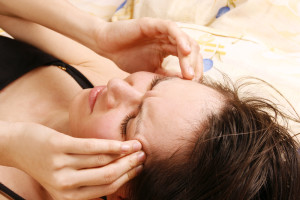 TMJ disorder is sometimes referred to as The Great Imposter because of its wide variety of symptoms that don’t even seem related to dental health. To add to TMJ disorder’s mystery, many patients who receive effective treatment for the dysfunction often see marked improvement in other conditions. Many experts believe the dramatic improvements may, in part, be the result of improved sleep quality, which often accompanies the relief of chronic aches and pains. Today, your Astoria dentist, Dr. Leibowitz, explores two common and somewhat related conditions—TMJ disorder and obstructive sleep apnea—and how treating them can significantly improve a patient’s overall quality of life.
TMJ disorder is sometimes referred to as The Great Imposter because of its wide variety of symptoms that don’t even seem related to dental health. To add to TMJ disorder’s mystery, many patients who receive effective treatment for the dysfunction often see marked improvement in other conditions. Many experts believe the dramatic improvements may, in part, be the result of improved sleep quality, which often accompanies the relief of chronic aches and pains. Today, your Astoria dentist, Dr. Leibowitz, explores two common and somewhat related conditions—TMJ disorder and obstructive sleep apnea—and how treating them can significantly improve a patient’s overall quality of life.
What is TMJ Disorder (TMD)?
TMJ disorder borrows its name from the temporomandibular joints, or TMJs for short. The lower jaw is connected to the skull by the TMJs located in front of each ear, and along with the muscles that surround and control them, these joints allow the jaw to move as necessary. TMJ disorder describes a condition where one or both joints become damaged, inflamed, and/or misaligned, typically due to excessive pressure from an imbalanced bite. The nerve that innervates the jaw, called the trigeminal nerve, permeates the majority of the head, neck, and face, and when disturbed, the pain can travel from the jaw to other areas along the nerve’s path. The trigeminal nerve also accounts for the majority of sensory input to the brain, and TMJ discomfort can significantly impact a patient’s physical and emotional wellbeing.
What is Obstructive Sleep Apnea?
Obstructive sleep apnea, or OSA, is a sleep disorder during which a patient repeatedly stops breathing while asleep. OSA occurs when oral tissues relax too much and block the airway, preventing the patient from drawing a breath, and is usually marked by extremely loud periods of snoring. OSA patients are not aware of apnic episodes that force the body to awaken and start breathing again. However, the continuous cycle deprives them of essential deep sleep, and OSA patients can exhibit symptoms of sleep deprivation in spite of their belief that they’re resting well.
Clearing a Path
Treating TMJ disorder and treating obstructive sleep apnea depend on the nature and severity of each case, but both treatments often share a similar premise—correcting abnormal oral structures so that they can operate properly. In the case of TMJ disorder, treatment involves addressing the underlying problem, such as realigning a crooked bite or, in extreme cases, reconstructive jawbone surgery to restore proper balance. Once undue pressure is lifted from TMJs, the joints can heal and the discomfort can dissipate. In some cases, correcting oral structures can also prevent the collapse of oral tissues during sleep and curb the risk of obstructive sleep apnea. Even if TMD isn’t accompanied by OSA, the relief can help you find more peaceful rest and enjoy the benefits that come with a good night’s sleep.
Better, More Comfortable Sleep with Help from Your Astoria Dentist
To learn more about TMJ disorder and obstructive sleep apnea, schedule a consultation with Dr. Leibowitz by calling our Astoria dentist’s office today at (718) 728-8320. Located in the 11106 area, we proudly serve patients from Astoria, Queens, Manhattan, Brooklyn, and the surrounding communities.


